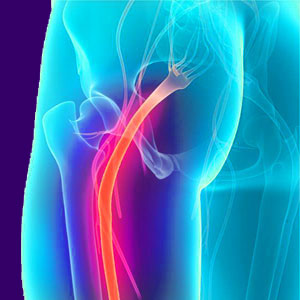
Pseudosciatica mimics true sciatica in every way except causation. True sciatica comes from a lumbar spinal source, while pseudo versions have other origins. There are actually many different causes of pseudo versions of sciatica, so diagnosing the actual source can be a very challenging proposition, explaining why so many patients endure long-term pain that defies treatment.
Sciatica symptoms are also very diverse, affecting patients differently and often changing in expression within the same patient regularly. Symptoms might also change location occasionally or regularly. In fact, unpredictability is a very common characteristic of all types of sciatica pain.
This dialog examines the differences between true spinally-motivated sciatica and pseudosciatica. We will focus on the latter condition and highlight some of its many possible causative mechanisms throughout the body and mind.
Pseudosciatica Symptoms
All types of sciatica symptoms can be incredibly diverse in expression, location, duration and intensity. There is no such thing as a typical case of sciatica. However, there are common expressions and common patterns which might be used to describe the suffering of any given patient at a given time. Remember, sciatica symptoms often change, sometimes wildly, so the description of the pain will also often change in relation to the whim of the symptomatic expression.
Sciatica symptoms will be experienced in the buttocks, legs and/or feet, since these are the areas of the body served by the sciatic nerve. Symptoms might be unilateral, affecting only one side of the body, or bilateral, affecting both sides. In bilateral expressions, the symptoms might be worse on one side or equally debilitating. Back pain is not a symptom of sciatica, although it often accompanies it, especially in cases of true spinally-motivated sciatica and regional oxygen deprivation.
Pain might take many forms, including sharp, dull, radiating and burning varieties. Additional expressions often include tingling, weakness and numbness in affected areas of the body. Muscular deficits, such as foot drop, are uncommon, but can occur in severe manifestations of sciatica.
Symptoms are most often reported in the buttocks, as well as in the rear and outer aspect of the leg or legs. Other common symptomatic locations include the inner thighs, the frontal thighs, the knee, the rear calf muscles and the bottom of the foot. The least common expressions are experienced in the frontal shin, the top of the foot and the heel of the foot.
Pseudosciatica or Sciatica?
True sciatica is also called spinal sciatica. This is the traditional definition of the symptom set which is sourced from a lumbar spinal nerve root causation. True sciatica can only come from compression or chemical irritation of the nerve roots that form the sciatic nerve, which include L4, L5, S1, S2 and S3.
Sciatica is therefore quite limited in its possible diagnostic conclusions, usually being linked to compression of one or more of the cauda equina nerve roots due to a herniated disc at L4/L5 or L5/S1, lumbar spinal stenosis, spondylolisthesis of L5 or a transitional L6 or abnormal lumbar spinal curvature, such as scoliosis or hyperlordosis.
Meanwhile, pseudosciatica includes symptoms that mirror true sciatica, but do not come from compression or chemical irritation of the lumbar spinal nerve roots. The possible causes of pseudo versions of sciatica are therefore incredibly diverse and difficult to pin down in many patients. This is particularly true since many of the common causes are actually normal parts of the aging process and are often scapegoated incorrectly as the source of symptoms.
Non-Spinal Sciatica Causes
There are many possible causes and contributors to pseudosciatica. Below, we list the most commonly observed sources of symptoms:
Piriformis compression of the sciatic nerve is called piriformis syndrome. This condition can cause sciatica symptoms that mimic a spinal source, although are often very diverse in terms of location, affecting much of the lower body and providing some clue to their origin.
The tissues of the sacroiliac joint can also impinge on the sciatic nerve in rare cases, especially the sacrospinous ligament. Although sacroiliac sciatica is not common, it can pose a diagnostic nightmare for care providers.
Cervical spinal stenosis can cause a diversity of problems, including sciatica symptoms. Since cervical stenosis is commonplace, this is actually a very common cause of pain, but is usually present with other higher level expressions that provide clues to its true origin. When lower body symptoms are the only expressions, symptoms are often mistakenly blamed on coincidental lumbar structural abnormalities and therefore resist successful treatment. Many patients in this predicament undergo unnecessary and unsuccessful surgery for incidental lumbar issues.
Local sciatic nerve injury, as well as cyst or tumor formation, can create pseudo versions of sciatica, as can localized muscular compression in the buttock or upper leg by various tissues.
Diabetes is a major source of sciatica-type expressions. Blood sugar testing should always be a first line diagnostic practice in patients with any form of neuropathy or seeming radiculopathy.
Some disease processes, as well as the collateral effects of some pharmacological agents, can cause sciatica pain and other related expressions. Therefore, all patients should undergo systemic health screening to be sure there is not some larger scale reason for sciatica to exist.
Ischemia of the sciatic nerve or of the lumbar spinal nerve roots is often a regional process that can create incredibly diverse symptoms in the lower body. In fact, symptoms which change often in expression, severity and location are most often linked to oxygen deprivation of the sciatic nerve or the lumbar spinal nerve roots which form it.
Our proven pain relief program can cure many forms of pseudo and true sciatica safely and effectively. You can get help 24 hours a day.





